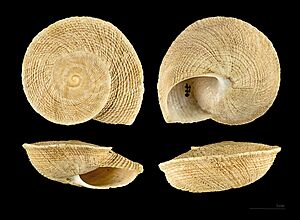Iberus gualtieranus facts for kids
Quick facts for kids Iberus gualtieranus |
|
|---|---|
 |
|
| Iberus gualtieranus | |
| Conservation status | |
| Scientific classification | |
| Synonyms | |
|
Iberus gualtieranus is a type of air-breathing land snail. It is a mollusk that lives on land and belongs to the snail family called Helicidae. This snail is the main example for its group, the Iberus genus.
You can only find Iberus gualtieranus in the southeastern part of Spain. This means it is endemic to that area.
Contents
Different Types of Iberus gualtieranus
Scientists sometimes recognize different types, or subspecies, of Iberus gualtieranus. It's like different breeds of dogs, but for snails!
Some studies list up to seven subspecies:
- Iberus gualtieranus alonensis
- Iberus gualtieranus campesinus
- Iberus gualtieranus carthaginiensis
- Iberus gualtieranus gualterianus
- Iberus gualtieranus mariae
- Iberus gualtieranus posthumus
- Iberus gualtieranus rhodopeplus
However, other scientists think some of these, like Iberus alonensis, Iberus campesinus, and Iberus carthaginiensis, are actually their own full species. They only recognize a few true subspecies of Iberus gualtieranus:
- Iberus gualtieranus gualterianus
- Iberus gualtieranus mariae
- Iberus gualtieranus ornatissimus
This last way of classifying them is what the IUCN (International Union for Conservation of Nature) uses.
What Does Its Shell Look Like?
The shell of Iberus gualtieranus is flat and has a sharp edge, like a keel on a boat. It also has cool patterns of spirals and lines.
Other similar snails, like Iberus alonensis and Iberus campesinus, have shells that are more round.
Where Does It Live?
Iberus gualtieranus likes to live in rocky, limestone mountains. These places often have a lot of sun and not much plant life. Sometimes, though, you can find them in areas with more plants.
These snails are most active in spring and especially in autumn. This is when the weather is not too cold, hot, or dry for them.
How Is It Protected?
Iberus gualtieranus is an endangered species. This means it is at risk of disappearing forever.
Some things that threaten these snails include:
- Wildfires: Fires can destroy their homes.
- Roads: Building new roads breaks up their habitat. This makes it harder for them to move around.
- Collecting: People sometimes collect these snails to eat them. They are quite rare and can be sold for a high price. This encourages more collecting, which hurts the snail population.



